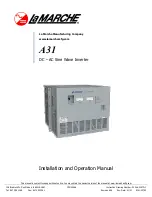
15
Wire Routing guidelines
Suggested cable size for DC input connections is 00 AWG. See Table 1-1 for the fuse rating required at
the battery end of the positive DC input cable.
Build the cables before rough fitting them to the vehicle. Note any points that will require special attention
to avoid chafing or exposure to heat sources. Eliminate potential trouble areas by installing clamps,
protecting wiring harnesses with plastic wrap, and installing grommets in feed through holes.
To prevent chafing, cables, plumbing, and installed equipment should not come into hard contact with
each other. Because the bodywork and structure can flex during operation, at least a quarter inch
clearance is advised between cables and nearby equipment. Do not route cables in high heat areas
without adequate thermal protection. Avoid exposure to chemical damage by using protective conduit or
wrap.
Torque DC input cable fasteners to 12.2 -13.6 Nm.
Torque Chassis Ground cable fastener to 6.6 – 7.3 Nm.
Model
DC
Input
AC
Input
AC
Output
Minimum
Wire
Size
(AWG)
Required
Fuse
(Amp)
Minimum
Wire
Size
(AWG)
Branch Circuit
Protection
Required
‐
Recommended
Fuse
(Amp)
Minimum
Wire
Size
(AWG)
Recommended
Fuse (Amp)
12
‐
110
‐
1000
3
125
12
15
14
N/A
(See
Note)
12
‐
110
‐
1800
1
200
12
20
12
N/A
(See
Note)
12
‐
110
‐
1000
‐
B2
3
125
12
20
14
N/A
(See
Note)
12
‐
110
‐
1000
‐
B4
3
125
12
20
14
N/A (See Note)
12
‐
110
‐
1800
‐
B4
1
200
10
30
12
N/A
(See
Note)
Note
- AC output fuse is not required as all models feature a 15 or 20 Amp AC output breaker
Table 1-1
General AC wiring considerations
AC Wiring Connectors –
AC wires are fixed to their respective barrier strip terminals by
clamp screws. The amount of insulation to be stripped off the individual wires should not be so
much that it is visible outside the connector.
AC and DC Wiring Separation –
Do not mix DC and AC wiring configurations. Do not
use the same conduit or panel. If wires must cross, only do so at 90° to one another. If
















































